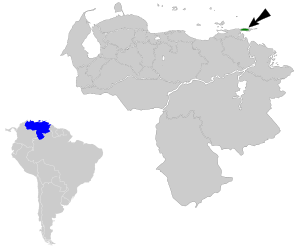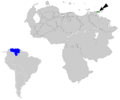Paria whitestart facts for kids
The Paria whitestart (Myioborus pariae), also known as the Paria redstart, yellow-faced whitestart, or yellow-faced redstart, is a small bird that belongs to the family Parulidae. This special bird lives only in one specific place: the Paria Peninsula in Venezuela. It prefers to live in humid forests, especially near the edges of these forests. Sadly, the Paria whitestart is an endangered bird because its home is slowly disappearing.
Quick facts for kids Paria whitestart |
|
|---|---|
| Conservation status | |
| Scientific classification | |
| Genus: |
Myioborus
|
| Species: |
pariae
|
 |
|
Contents
What is the Paria Whitestart?
The Paria whitestart is a type of songbird. It was first described by scientists in 1949. These birds are known for their bright colors and active behavior. They are part of a group of birds often called "whitestarts" or "redstarts" because of the way they flash their tails, which often have white or reddish patches.
What Does it Look Like?
While the name "whitestart" might make you think of white, one of its other names, "yellow-faced whitestart," gives us a clue about its appearance. It likely has some yellow on its face, which helps it stand out. Like many birds in its family, it's probably small and quick, moving through the trees to find food.
Where Does it Live?
This bird is endemic to the Paria Peninsula. This means it can't be found anywhere else in the world! The Paria Peninsula is a beautiful area in the northeastern part of Venezuela. The bird lives in humid forests there, which are forests that get a lot of rain and are often very green and lush. They particularly like the edges of these forests, perhaps where the trees meet open areas.
Why is it Endangered?
The Paria whitestart is listed as an endangered species. This is a serious problem because it means there are very few of these birds left in the wild. The main reason for this is something called habitat loss.
What is Habitat Loss?
Habitat loss happens when the natural home of an animal or plant is destroyed or changed so much that it can no longer live there. For the Paria whitestart, this means the humid forests on the Paria Peninsula are shrinking. People might be cutting down trees for farming, building, or other activities. When the forest disappears, the birds lose their homes, their food sources, and places to raise their young. Because this bird only lives in one small area, habitat loss affects its entire population very quickly.
How Can We Help?
Protecting endangered species like the Paria whitestart is very important. Here are some ways people can help:
- Protecting Forests: Keeping the remaining forests safe from being cut down is the most important step. This might involve creating national parks or protected areas.
- Educating People: Teaching local communities about the importance of these birds and their habitat can help.
- Research: Scientists continue to study these birds to learn more about their needs and how best to protect them.
By working together, we can help ensure that the Paria whitestart continues to thrive in its unique home for many years to come.
Images for kids
See also
 In Spanish: Candelita de Paria para niños
In Spanish: Candelita de Paria para niños



